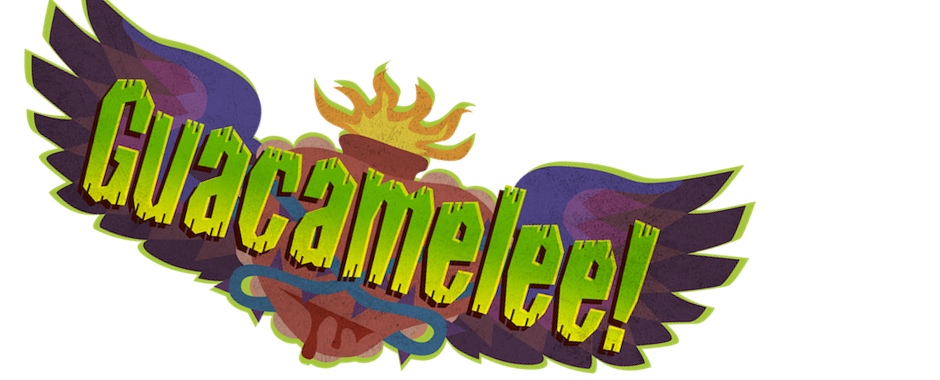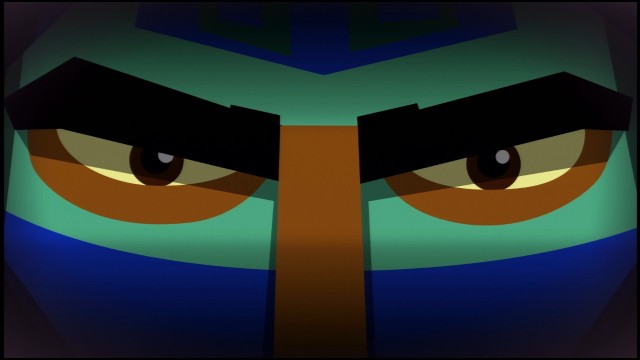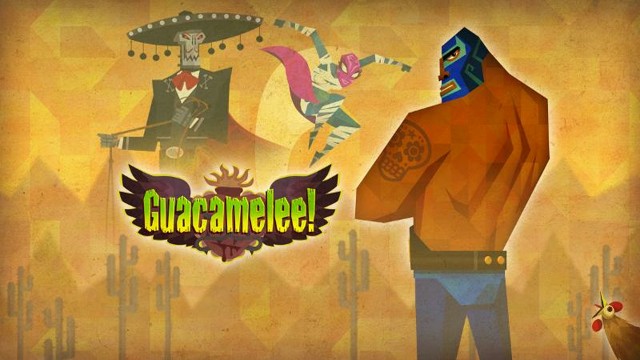After scooping up numerous indie accolades and finally coming to the PlayStation Store, we can declare something about Guacamelee! that we do not declare lightly; It’s one of the single best games in the PlayStation Store library, both the PS3’s and the Vita’s! Coming to us from the likes of Toronto developer, Drinkbox Studios, who previously delivered the similarly awesome Tales from Space games, Guacamelee! is a PlayStation-exclusive cross-play title that will award you both the PS3 version and the Vita version of the game upon a single purchase of either, with a save file that can be freely transferred back and forth between platforms via the cloud, within seconds.
Initial press materials did appear to show off an Xbox Live Arcade version of the game, but whether it’s delayed or cancelled is unclear. Guacamelee! ended up being funded by the new PlayStation Pub Fund program, allowing indie games simultaneous cross-releases on PS3 and Vita, which may have forced the Xbox Live Arcade edition to be axed, since Microsoft appears to be denying its existence at this point. Too bad, because it looks like this excellent game is going to be exclusively enjoyed by the PlayStation community in that case. Regardless, we did an initial playthrough of the game on Vita, switching to PS3 for a second playthrough on the unlockable Hard Mode, and regardless of which platform you play it on, Guacamelee! is a masterpiece of indie game design!
You take control of Mexican agave farmer, Juan Aguacate, who valiantly attempts to rescue the daughter of El Presidente, kidnapped by undead charro, Carlos Calaca and his posse of goons. Unfortunately, the ordinary Juan is killed pretty effortlessly by Calaca, seemingly cutting the game short in the first few minutes. Juan reawakens in the World of the Dead however, where he is recognized for his courage and noble heart, and is subsequently awarded a magical luchador mask that can return him to the World of the Living. Reborn as a powerful, justice-dealing luchador, Juan takes off in pursuit of Calaca to stop the villain from merging both the World of the Dead and the World of the Living in a plot to rule them both, and attempting to reclaim his true love, the daughter of El Presidente (no, she’s never named, and neither is El Presidente, who isn‘t even seen!) in the process!
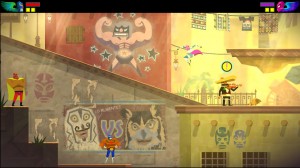 Guacamelee! progresses in a big open world that combines elements of platforming, melee combat, and acrobatic-flavoured puzzle-solving. It’s mostly an action-adventure game, but also somewhat of a platformer as well. If you’ve played any of Nintendo’s various Metroid games, or any of the second-generation Castlevania games, Guacamelee! plays very much like either of those, making it fit the description of a ‘Metroidvania’ title, which is the gaming community’s overall term for these kinds of games. As Juan gains new abilities, more sections of the game world will open up to you, allowing you to pursue Calaca further, and get that much closer to saving the world and getting the girl. In fact, speaking of Metroid, Drinkbox Studios isn’t shy about demonstrating their love of that series, since Juan, and we’re not joking here, gets his new abilities from smashing ‘Choozo Statues’. No, not Chozo Statues like you’d see in the retro Metroid titles, ‘Choozo Statues’. Oh, they look the exact same, yes, but these happen to be part of the private collection of a shape-shifting goat man with designs on Juan’s potentially non-existent mother. Did we mention that Guacamelee! doesn’t really take itself all that seriously much of the time?
Guacamelee! progresses in a big open world that combines elements of platforming, melee combat, and acrobatic-flavoured puzzle-solving. It’s mostly an action-adventure game, but also somewhat of a platformer as well. If you’ve played any of Nintendo’s various Metroid games, or any of the second-generation Castlevania games, Guacamelee! plays very much like either of those, making it fit the description of a ‘Metroidvania’ title, which is the gaming community’s overall term for these kinds of games. As Juan gains new abilities, more sections of the game world will open up to you, allowing you to pursue Calaca further, and get that much closer to saving the world and getting the girl. In fact, speaking of Metroid, Drinkbox Studios isn’t shy about demonstrating their love of that series, since Juan, and we’re not joking here, gets his new abilities from smashing ‘Choozo Statues’. No, not Chozo Statues like you’d see in the retro Metroid titles, ‘Choozo Statues’. Oh, they look the exact same, yes, but these happen to be part of the private collection of a shape-shifting goat man with designs on Juan’s potentially non-existent mother. Did we mention that Guacamelee! doesn’t really take itself all that seriously much of the time?
In fact, Drinkbox Studios didn’t stop at referencing Metroid throughout the game either! Other Nintendo games like Super Mario Bros., Donkey Kong and The Legend of Zelda are also cutely referenced (as is Final Fantasy), with their lead characters being re-imagined as luchadors in background posters, and satirical nods to classic moments in both franchises coming up at various parts of the game. We don’t want to spoil these hilarious moments, but we will say that Guacamelee! may have defied copyright law by featuring Error, yes the exact same Error character that was made infamous in Zelda II: The Adventure of Link on NES, who is finally explained and made part of a side quest that you can do for a Trophy, a Trophy titled I AM ERROR. Brilliant. It’s actually kind of strange and surreal to see so much Nintendo satire in a game that’s made exclusively for PlayStation platforms, but Guacamelee! evens the scales by not only referencing classic Nintendo games, but also more recent indie games of its same ilk, including the highly beloved Castle Crashers, and Drinkbox Studios’ own Tales from Space: Mutant Blobs Attack!!. Needless to say, if you don’t get at least a good chuckle out of these inspired and hysterical nods to both classic and indie gaming, you’re not a real gamer.
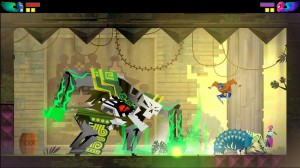 What’s even more surprising about Guacamelee! however is how effectively it also pulls off some surprisingly dramatic moments amidst all of the comedy as well. Don’t get us wrong, the game is frequently hilarious, even when it’s not referencing other games, but even with the story being told entirely in text with no real voice acting, there’s a good few moments that will get an emotional rise out of the player as well. Again, we can’t spoil these, but we can say that Guacamelee! stands as a superb example of how to make a game funny without making it stupid, and how to keep the player invested in a light-hearted, but still reasonably emotional plot. All told, Guacamelee! is just brilliantly written and conceived all around, and you can tell that Drinkbox Studios really put a lot of love and care into this game, but still had loads of fun making it!
What’s even more surprising about Guacamelee! however is how effectively it also pulls off some surprisingly dramatic moments amidst all of the comedy as well. Don’t get us wrong, the game is frequently hilarious, even when it’s not referencing other games, but even with the story being told entirely in text with no real voice acting, there’s a good few moments that will get an emotional rise out of the player as well. Again, we can’t spoil these, but we can say that Guacamelee! stands as a superb example of how to make a game funny without making it stupid, and how to keep the player invested in a light-hearted, but still reasonably emotional plot. All told, Guacamelee! is just brilliantly written and conceived all around, and you can tell that Drinkbox Studios really put a lot of love and care into this game, but still had loads of fun making it!
Of course, as easy as the writing and storyline are to appreciate, it’s the area design that will really sell you on how superb the game is! Juan’s skills are exceptionally designed, since they’re not only useful for combat, but also equally necessary to master for platforming and navigation as well. Sure, you can launch enemies into the air with a super uppercut, but you’ll also need said super uppercut to launch Juan upwards to just barely clear an overhead ledge as well. Likewise, Juan may be able to escape a heated combat scenario by literally turning into a chicken and running away (yes, one of the abilities you eventually gain allows you to turn into a chicken!), but you’ll mainly be using it to navigate tight spaces that Juan couldn’t get through in his normal human form. The seamless blend of combat and platforming applications in each available skill makes the gameplay flow very well and generally handle very seamlessly, making each area and challenge a huge amount of fun to navigate! You don’t just have a list of arbitrary combat and exploration skills that you shift between as the game demands, but simply a list of luchador techniques that have many uses, making them loads of fun to experiment with, especially considering how superbly designed each section of the game is!
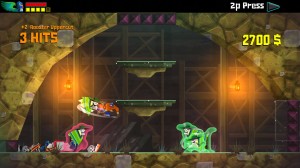 Of course, as enjoyable as the platforming is, the combat is plenty engaging as well. It may take a bit of practice to get used to how Juan handles himself in battle, but once you get the hang of the combat controls, you’ll agree that it’s one of the best combat systems in any PlayStation Store game to date! Juan can punch enemies normally by pressing the Square button, but when he’s damaged enemies enough to stun them, he can grab them with the Triangle button, allowing the player to quickly aim with either the Directional Buttons or Left Analog Stick to either launch them high into the air, or piledrive them into the ground. All the while, you can press the Circle button combined with various directional movements to add Juan’s special moves into your flurry of punches and tosses, allowing skilled players to juggle enemies and knock them all around the area, potentially taking them out before they can even lay a hit on Juan! Of course, you’ll need to dodge enemy attacks all the while by rolling away with L2/L, but even this can be incorporated into your combos. In motion, a skilled player can take on even a crowded room of over ten simultaneous enemies with incredible agility and flexibility, avoiding damage altogether when they’re skilled enough, so long as they can pull off the right combination of punches, juggles, special moves and dodges, even when enemies start incorporating shields that can only be broken by certain special moves. Even just watching a skilled player utilize Guacamelee!’s combat system ably is a thing of a beauty, especially during the handful of intense and very well-designed boss battles, which will really strain your skills on Hard Mode especially!
Of course, as enjoyable as the platforming is, the combat is plenty engaging as well. It may take a bit of practice to get used to how Juan handles himself in battle, but once you get the hang of the combat controls, you’ll agree that it’s one of the best combat systems in any PlayStation Store game to date! Juan can punch enemies normally by pressing the Square button, but when he’s damaged enemies enough to stun them, he can grab them with the Triangle button, allowing the player to quickly aim with either the Directional Buttons or Left Analog Stick to either launch them high into the air, or piledrive them into the ground. All the while, you can press the Circle button combined with various directional movements to add Juan’s special moves into your flurry of punches and tosses, allowing skilled players to juggle enemies and knock them all around the area, potentially taking them out before they can even lay a hit on Juan! Of course, you’ll need to dodge enemy attacks all the while by rolling away with L2/L, but even this can be incorporated into your combos. In motion, a skilled player can take on even a crowded room of over ten simultaneous enemies with incredible agility and flexibility, avoiding damage altogether when they’re skilled enough, so long as they can pull off the right combination of punches, juggles, special moves and dodges, even when enemies start incorporating shields that can only be broken by certain special moves. Even just watching a skilled player utilize Guacamelee!’s combat system ably is a thing of a beauty, especially during the handful of intense and very well-designed boss battles, which will really strain your skills on Hard Mode especially!
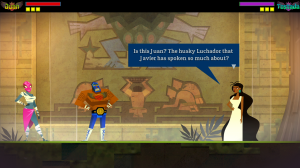 Perhaps the most inspired and surprisingly clever mechanic however is when Juan eventually gains the ability to shift between the parallel World of the Living and World of the Dead at will. This has implications in both combat and exploration, since certain paths will become open or closed off, depending on whether Juan is in one world or another, and certain terrain may become hazardous in one world, where it is benign in the other. During the more challenging platforming sections, players will need to incorporate pressing R2/R with the right timing to phase in and out of worlds so as to remove obstacles in their way, or make terrain they’re speeding towards safe to platform off of, which is not only unique, but also clever and creative. Likewise, enemies will start only existing in one world, but can damage Juan in either, requiring players to phase between worlds in combat amidst their combos, adding an even better way to reward player skill and panache beyond just knocking enemies around with the proper precision. It’s another very inspired mechanic all around that firmly separates Guacamelee! from other games, in all the right ways!
Perhaps the most inspired and surprisingly clever mechanic however is when Juan eventually gains the ability to shift between the parallel World of the Living and World of the Dead at will. This has implications in both combat and exploration, since certain paths will become open or closed off, depending on whether Juan is in one world or another, and certain terrain may become hazardous in one world, where it is benign in the other. During the more challenging platforming sections, players will need to incorporate pressing R2/R with the right timing to phase in and out of worlds so as to remove obstacles in their way, or make terrain they’re speeding towards safe to platform off of, which is not only unique, but also clever and creative. Likewise, enemies will start only existing in one world, but can damage Juan in either, requiring players to phase between worlds in combat amidst their combos, adding an even better way to reward player skill and panache beyond just knocking enemies around with the proper precision. It’s another very inspired mechanic all around that firmly separates Guacamelee! from other games, in all the right ways!
The only real downside to Guacamelee! in fact is that it’s short, very short. You can easily beat the game in one sitting, taking you only about 4-5 hours, and maybe a bit longer on Hard Mode, which is unlocked after you beat the game for the first time. Even scooping up every Trophy will only add a couple more hours to the gameplay, and yes, Guacamelee! does feature both a Platinum Trophy and one shared Trophy roster between the PS3 and Vita editions, so you won’t need to earn every Trophy twice, even if you’re constantly hopping between platforms. We can appreciate that Drinkbox Studios was going for a quality-over-quantity design philosophy, and Guacamelee! certainly maximizes the appeal of its gameplay by not overstaying its welcome, making every combat scenario and bit of stage design count for all the appeal it can muster. Still, it’s a real testament to how much we loved this game when we think about how much it left us wanting more.
Like we said though, Guacamelee! is an amazing experience on either platform, especially if you own both! If you do own both, and are curious about any differences, we’ll outline our experience with a complete playthrough on both platforms for you:
Guacamelee! seems mainly designed with the PS3 in mind, since the graphics are scaled a little better on PS3 versus Vita, and when playing with a Dual Shock 3 controller, you can really feel the power of Juan‘s bone-crushing hits as your controller vibrates with every blow, something that you can‘t enjoy when slugging it out on Vita. On Vita, the game is still plenty enjoyable, but it doesn’t seem as well-optimized for Sony’s handheld, since the graphics, while still just as colourful and eye-popping as they are on PS3 thanks to the handheld‘s gorgeous OLED screen, look really shrunken down and zoomed out further away. This means that you’ll need to squint a lot more when playing on Vita, since everything is so small, even for players with good eyesight.
Fortunately, the Vita version compensates by having less cluttered controls, sometimes operating a little more smoothly during combat scenarios. On PS3, the dodging and world-shifting maneuvers are mapped to L2 and R2 respectively, which makes them more difficult to reach when trying to do finger gymnastics with the Directional Buttons and Square, Triangle, Circle and X buttons, and that’s assuming you can keep them straight with the L1 and R1 buttons, with L1 even being the button that turns you into a chicken! On Vita, you turn into a chicken by swiping downward on the Touch Screen, which is more intuitive and less intrusive during combat, especially since the L2 and R2 functions are now just mapped to L and R, which are much easier to reach when working with the other buttons now. The Vita version’s Left Analog Stick is also a little more reliable if you prefer to move Juan with analog control, though considering that the entire game is on a 2D plane, the Directional Buttons will likely be preferable for most players in either case, even though the game indicates to move with the Left Analog Stick during tutorial prompts.
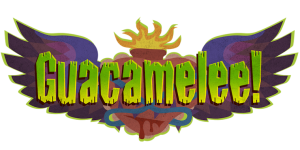 The Vita version of Guacamelee! may have the advantage of portability, but on top of featuring vibration capability in the Dual Shock 3 controller, the PS3 version also offers local co-op play as an exclusive extra, allowing a second player to join Juan as his mask’s guardian spirit by picking up a second PS3 controller and pressing Start. The Vita version is single-player-only, but it doesn’t really matter, because the co-op doesn’t make that much of a difference. It’s fine, but it does feel kind of tacked-on and unnecessary, especially since it’s limited to local play. Both players share the same abilities as far as they’ve unlocked, and thankfully, the co-op is drop-in/drop-out, so the first player’s session won’t end if the second player leaves. Still, the co-op feels superfluous, and most players probably won’t bother with it.
The Vita version of Guacamelee! may have the advantage of portability, but on top of featuring vibration capability in the Dual Shock 3 controller, the PS3 version also offers local co-op play as an exclusive extra, allowing a second player to join Juan as his mask’s guardian spirit by picking up a second PS3 controller and pressing Start. The Vita version is single-player-only, but it doesn’t really matter, because the co-op doesn’t make that much of a difference. It’s fine, but it does feel kind of tacked-on and unnecessary, especially since it’s limited to local play. Both players share the same abilities as far as they’ve unlocked, and thankfully, the co-op is drop-in/drop-out, so the first player’s session won’t end if the second player leaves. Still, the co-op feels superfluous, and most players probably won’t bother with it.
Ultimately however, the difference is pretty much a wash, especially since you can freely transfer your save file between platforms to play on either at your leisure. Like we said, the game is superb on both PS3 and Vita, and whether you own just one of these platforms or both, this game demands to be experienced by any and all PlayStation gamers! It may be over too quickly, but while it lasts, Guacamelee! stands as a stunning example of how to do an indie game right, and even manages to overtake the strong Tales from Space games as Drinkbox Studios’ best game to date! It’s fun, it’s colourful, it’s hilarious, and best of all, it lets you unleash hell as a mighty luchador! As silly as they look, you’ve got to be honest, who doesn’t love luchadors?! Bottom line: This is the best use of one’s PlayStation funnybucks in years, and a true must-play for anyone with access to the PlayStation Store!
Well, what are you waiting for?! Vaminos!

